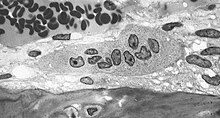Structural Biochemistry/Development and Discovery of Zanamivir & Oseltamivir for Various Diseases
History of Osteoporosis
[edit | edit source]
Osteoporosis is a bone disease that can lead to fractures and deteriorating. Bisphosphonate, also known as Diphosphonate are drugs known for treating and reducing the risk of contracting the illness. It is one of the key elements used by chemist as a pathway to finding the drugs for Osteoporosis. Bisphosphonate has the ability to bind with a naturally occurring mineral called Hydroxylapatite, that can make up 70% of bone. Alendronate (Fosamax), ibandronate (Boniva), risedronate (Actonel), and zoledronic acid (Reclast) are three examples of drugs used to treat osteoperosis.

Treating Osteoporosis
[edit | edit source]The bisphosphonates are synthetic compounds that have been used as water softeners in canals and irrigation systems since the mid-nineteenth century. Their efficiency in treating osteoporosis can be ascribed to the alignment of biological and physicochemical properties of the compound. Bisphosphonates have impressive layers of cellular selectivity, which compose long-acting drugs that inhibit the resorption of bone by osteoclasts safely. After binding with Hydroxylapatite on the bone surface, approximately 50% of bisphosphonates will stick there and the half-life of bone-bound alendronate is estimated to be around 10 years. The dose of drugs that do not stick around will be excreted rapidly, and bisphosphonates' low cell permeability will minimize their exposure to other tissues, which in terms lower the probability of having side effects. This property of essential targeting to bone is very useful for the subsequent cellular activities in treating osteoporosis. During bone resorption, osteeoclasts are attached to bisphosphonates and hence will not be able to resorb bones.


History of Influenza Viruses
[edit | edit source]
Influenza viruses, also referred to as the flu is a disease that is more severe that a normal cold and is highly contagious. The virus can be transferred through air, cough, sneeze, as well as direct contact. It affects all age group, but young children have a tendency to catch the disease more than adults. It is a seasonal disease that spread around the world and kill thousands and thousands of people each year. In the case of the influenza target neuraminidinase, crystallographic analyses of N2 and type B neuraminidases have been essential to understanding how activesite plasticity affects the emergence of distinct resistant variants to the current commercial drugs, zanamivir (Relenza®) and oseltamivir (Tamiflu®). Zanamivir, the first drug on the market (10), shows poor oral bioavailability (2%), likely reflecting its zwitterionic character at physiological pH (11). Oral inhalation is required. In the case of oseltamivir (12), the carboxylate is an ethyl ester prodrug, thereby rendering the molecule cationic, which enhances oral absorption (75%). The required carboxylate is generated in the host by enzymatic hydrolysis (13). In addition, the guanidinium group of zanamivir is simplified to an amino group, and the glycerol moiety is redesigned in oseltamivir to a hydrophobic ether, which results in a different enzyme conformation upon binding. This modification may be problematic in the emergence of resistance to oseltamivir.
Zanamivir (Relenza)
[edit | edit source]Osteoporosis: The company Biota discovered Zanamivir, a drug made help bone conditions such as Osteoporosis and similar diseases. Of its kind, it was the first commercial drug on the market to serve as patients with bone diseases, but unfortunately, it was proven to have low effectiveness due to its poor bioavailability of 2%. The human body was unable to fully absorb the dosage because of Zanamivir's zwitterionic character.
Biota should be looking into developing an ester of zanamivir to increase its oral bioavailability, but it did not do so for good reasons. During Biota's discovery of this drug, the Gilead group prepared free carboxylate and guanidinium analogs of oseltamivir, which is a prodrug. To mimick Zanamivir, the Gilead group replaced the amino group of Zanamivir with guanidinium group ultimately resulted in a loss of oral bioavailability. Therefore, the company came to the conclusion that the prodrug form of zanamivir was not more bioavailable that its original form probably because of some mitigating effect of the guanidinium group. Apparently, when it comes to producing medicines, aligning one parameter with the grand picture may negatively impact another parameter. Zanamivir was licensed to GlaxoSmithKline for final development; despite Biota or GSK's effort to make the drug more orally bioavailable, this drug was outsold by the orally active oseltamivir.

Influenza: In an experiment on animals and man, inhaling doses of Zanamivir is an effective treatment for influenza. Although Zanamivir is and ester prodrug, if taken orally, the medicine will not successfully distribute through out the body and therefore, will not fight against the infectious disease. Due to this matter, many attempts have been made to better the pharmacological properties of Zanamivir by changing the structure of the compound.
Oseltamivir (Tamiflu)
[edit | edit source]
Osteoporosis: Following the discovery of Zanamivir, to improve bone diseases, Gilead group generated a drug called Oseltamivir. This new medicine serves the same purpose as Zanamivir but it was highly effective and it outsold Zanamivir by 3 to 1. This drug was more successful than Zanamivir because its carboxylate is an ethyl ester prodrug, in which enhancing the molecule to be cationic, and therefore, an increase in oral absorption (75%).

Influenza: By looking to improve the oral intake of Zanamivir, researchers redesigned the structural compound of pyran by removing carboxylic acid, and changing it into a carbocyclic scaffold, in which discovered an active antiviral product (Oseltamivir) that targets influenza viruses and can be taken orally. Overall, Statistics shows that in Japan, Oseltamivir was more commonly used, roughly 90 times more than Zanamivir.
References
[edit | edit source]Kozarich, John W. "The Biochemistry of Diseases: Desperately Seeking Syzygy." Annu. Rev. Biochem. (2009): 55-63. Web.
Colman, Peter M. "New Drug Antiviral and Resistance." Annu. Rev. Biochem. (2009): 95-118. Web.
Image source: wikimedia-commons

